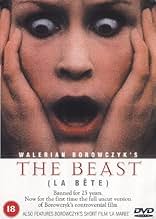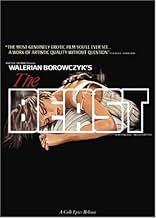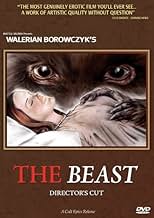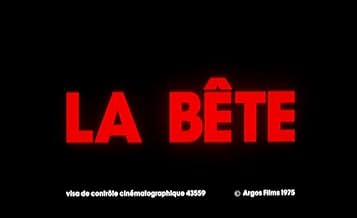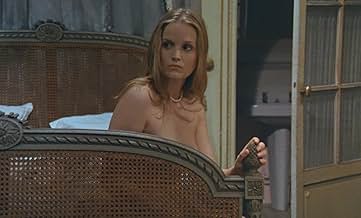Die Tochter eines verstorbenen Geschäftsmanns begibt sich mit ihrer Tante zum Anwesen ihres zukünftigen Ehemanns und ahnt nichts von den seltsamen Gerüchten, die den Namen der Familie umscha... Alles lesenDie Tochter eines verstorbenen Geschäftsmanns begibt sich mit ihrer Tante zum Anwesen ihres zukünftigen Ehemanns und ahnt nichts von den seltsamen Gerüchten, die den Namen der Familie umschatten.Die Tochter eines verstorbenen Geschäftsmanns begibt sich mit ihrer Tante zum Anwesen ihres zukünftigen Ehemanns und ahnt nichts von den seltsamen Gerüchten, die den Namen der Familie umschatten.
- Regie
- Drehbuch
- Hauptbesetzung
- Duc Rammendelo
- (as Dalio)
Empfohlene Bewertungen
The long (way too long) scene between an Aristocratic young woman and the supposedly horrifying but the most laughable I've ever seen in the movies creature with truly impressive...well anatomy, is set to the clavichord music of Scarlatti and is hysterical. My husband and I both laughed out loud at the exaggerated details of the encounter. The moral of the scene is - beauty can and will defeat the monster. The question is - who is the target audience for the film? For an erotic picture, it is too verbose; for an art movie - it's got too many jaw-dropping scenes of sheer madness and I'd say an abrupt ending. IMO, the film creator did not mean for it to be a serious drama. As a parody of art house/horror/erotica, it is funny and certainly original. Have a good laugh and try not to look for some deep meaning. This story of the curious Beauties and the lustful Beasts certainly is not recommended for co-viewing with the children. The opening scene that may shock an unprepared viewer much more than the infamous scene of bestiality can be successfully used On Discovery channel for the program like "In the world of animals - mating habits and rituals of horses".
The film starts off with a sequence that sees a randy male horse mount a female. This opener puts an exclamation mark on the film and prepares the audience, in some ways, for the incredible, tour de force of eroticism that they are about to see. The scenes which see the beast mate with the woman are gratuitous and shocking, and are bound to offend many people (hence the reason it was banned for over 20 years), but these scenes are not merely an excuse for Borowczyk to shock the viewer; this film has a defining point. As said during the film; the only difference between man and beast is intelligence. Both man and beast have instincts, only man knows how to control them. The Beast explores this difference between man and beast through sexuality; the fantasy sequence in which the beast appears epitomises the control of human desire, and it is only when the central female character lets go of her control that she can see the beast. The film has strong themes of the age-old story of 'beauty and beast' weaved into it, and overall this is a shockingly morbid tale of lust, but not without a moral.
Many criticise the scenes around the film's shocking sex sequences for being boring, but these scenes are important to the film's story. Without these scenes, we wouldn't get to know the characters or the story of the beast, and, most importantly; the story of 'beauty and the beast' would not be able to have it's horrifying conclusion dealt to the audience, and as that is one of the key elements of the film; it would be a real shame. Besides that, Borowczyk keeps his audience entertained through these scenes, not with shocks, but with dialogue and the upper class persona of the family, along with the beautiful shots of the mansion's ground would not be seen, and therefore the stark contrast between that and the events later on in the film would not exist either.
Overall, The Beast is a shocking film. It's portrayal of a taboo subject and the shocking way it is portrayed will ensure that this film is not for everyone. However, if you can get over the film's shock, and embrace The Beast; what awaits is a skilful and beautiful piece of art that should not be missed by anyone that is willing to give this film a chance.
'The Beast' appeared approximately half way in a career spanning art house successes such as 'Blanche' (1971) to the creative nadir of 'Emmanuelle 5' (1987). Most of his films represent sensuality especially the feminine kind - being discovered as a matter of primacy then typically, explored in erotic, private rituals. The urgency at which females seek satisfaction in these works is shocking or refreshing according to one's viewpoint. Borowczyk's heroines, when apart from their lovers, typically pleasure themselves quietly in chambers, as in the 'cucumber' scene in Contes Immoraux/Immoral Tales' (1974)(A film in which the content of the flashback in here was originally to have appeared). Although they take their fulfillment, their secret fantasies are largely unexpressed. The Beast' makes explicit this process of gratification, and places sexual dreams before our eyes, most noticeably in an extended flashback sequence. This of course is done after literary precedent (albeit from a tradition typically suppressed or hidden, as in the film itself). On one level of course, Borowczyk has made a variation on Beauty and The Beast. More precisely his film has its roots firmly in the adult realm of the pre-victorian fairy tale, as well as claiming an ancestory from the verse fables which have enlivened French culture, most famously by La Fontaine.
To be honest, much of the plot of 'The Beast' is forgettable, a dramatic concoction which serves a set-up for the director's impending erotic tour-de-force. The modern story is a comedy of sexual manners, contrasting the elegance of life in the chateau with the moral squalor and hypocrisy of its inhabitants. Pierre's repeated, frustrated dalliances merely anticipate the grand inter-species coupling to come. The Marquis' plans, his shabby chateau and brutish son, the forced wedding provide so much window dressing, as stereotypical as the tales that inspired them although Mathurin (played by a suitably glum Pierre Benedetti) comes across as sensitive as well as animal. Standing out without apology, the real concerns here are like the phallic column-stump prominent in the chateau grounds, the images remaining with the viewer after the film is finished exactly those which the director intended the irrational and sexual.
Although nominally set in the twentieth century, the action of the film could with little difficulty be transposed to earlier times - the middle ages say, where the director has found inspiration before. Apart from the telephone and car, very little intrudes from the modern era. The chateau, full of sharp sounds and still silence, old wooden floors and hushed servants, has an almost institutional air. The presence of the clergy in the house paints a religious-like environment, and one where correctness and arousal go hand in hand - a scenario familiar from such other Borowczyk films as 'Interno di un convento/Behind Convent Walls' (1977). The heated harpsichord music of Scarlatti with its strong rhythmic pattern and run of impassioned semi-quavers, adds to the impression of sexual emotions scuttling free beneath the surface. Outside, the overgrown, rambling grounds have a timeless quality about them. One can almost imagine Little Red Riding Hood skipping through the trees on an errand.
Apart from the baldness of its sexual images, the reason why 'The Beast' provoked such an uproar when first released is because it is an honest, adult work. It deals with human sexuality real or imagined, with complete open handedness, admitting the pretend life without hesitation. The fantastic elements of Lucy's masturbatory day dreams, seen at length and so vividly after she reads the diary, should alert the viewer to that. Mathurin is more than just the other half of the Beauty and The Beast equation. He is symbol-made-concrete of the sexual fantasies she (and by extension, we) enjoy. The 200 year cycle of the beast's reappearance truly marks the return of the repressed', and Lucy's flashback the liberation of desire. More than this her enjoyment of lustful fantasy implies how much we should become the honest brokers of our imaginations. The original view of the BBFC not withstanding, the result is then that any notion of pornography fades away in favour of recognising our true natures. Unfortunately, as Borowczyk retreated into more commercial projects, this straightforwardness disappeared to be replaced by exploitation. As a result The Beast' remains as his most striking piece of film making. After 25 years after it was made it still creates a memorable impression.
Wusstest du schon
- WissenswertesActor Bryan Pringle once took a date to a screening of Das Biest (1975) in London. She was reportedly "appalled by his taste in films."
- Zitate
Priest: Spring is the cause of our excitement. We, frail humans, we are like animals, we suffer the laws of nature. Alas!
Pierre de l'Esperance: Happily, we have this intelligence, this heavenly gift, which enables us to fight our instincts.
- Alternative VersionenThe film was rejected for UK cinema in 1978 by the BBFC and released on video in 1988 (as "Death's Ecstasy") with around 9 minutes of distributor pre-edits. It was finally passed completely uncut for cinema and video in 2001.
- VerbindungenEdited from Unmoralische Geschichten (1973)
Top-Auswahl
- How long is The Beast?Powered by Alexa
Details
- Laufzeit1 Stunde 38 Minuten
- Sound-Mix
- Seitenverhältnis
- 1.66 : 1
Zu dieser Seite beitragen






